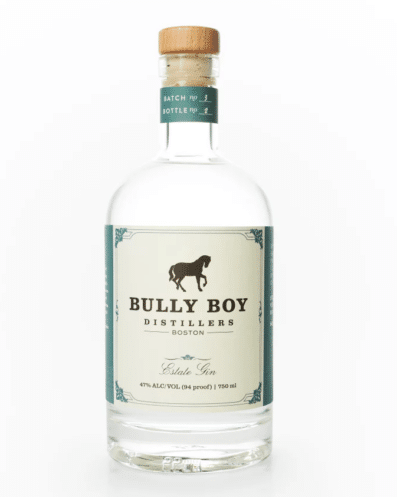Bully Boy Distillery‘s Estate Gin is distilled from a combination grain and apple. From there they add a few different botanicals including two kinds of juniper. The first they source from Albania. The second is juniperus Virginiana— a different species altogether. Also known as Red Cedar, its essential oil is much woodier in aroma owing to a higher quantity of elemol than found in juniperus Communis. Though other studies have found that its berries have a much higher quantity of Limonene, a citrusy flavor often associated more with oranges and their ilk [source].
Tasting Notes
Bully Boy’s Estate Gin begins with a slightly fruit-forward nose. Notes of Hibiscus tea, pear cider, and rose hips fill the nostrils. Luscious, and almost efflorescent, this estate seems a pastoral manor with flowers and fruit trees.
The palate starts with fruit. Apples with custard segues into hints of meringue. A dry coriander and pepper note flashes in and out of existence mid-palate. Sweet lemons— more specifically lemon meringue pie— sharply detours into lavender oils, resinous juniper, and roses.
Estate Gin’s palate is disjointed. Each botanical seems to be the star of its own verse. But the taste is interesting. There’s moments where I want it altogether, and other moments where I really dig the way the lemon custard note segues unexpectedly into the latter half of the palate.
Cocktails
Playing to its citrus-forward and contemporary style strengths, Estate Gin works well with a simple supermarket tonic. Bright, citrusy, a bit piney— I find the bitterness seems to bring a bit of harmony.
Bartenders may find Estate Gin a difficult mixing gin. It yields some unexpected moments on the palate in many cocktails.
I found the best cocktail with Estate Gin to be a Martini— 5:1, served up with a twist. But save the olives, I’m not quite sure it works in a Dirty Martini.
Overall, Estate Gin
Estate Gin has its moments but it never quite comes together for me. Depending on what you’re using it for, fans of contemporary style gin may find it an exciting companion in a Gin and Tonic or to make a Martini that suggests a slightly spicier Malfy Gin.
Others may find that it’s lack of coherent botanical vision sets Estate Gin to be a niche market gin.
Made possible through the New England Gin Exchange
Special thanks to John at Foodie Pilgrim. Since 2012, John has shared and sourced gins from New England and nearby that we at The Gin is In haven’t tried yet. This gin sample was shared by John, who is also a big fan of gin. So check out his New England Gin Reviews as well.

